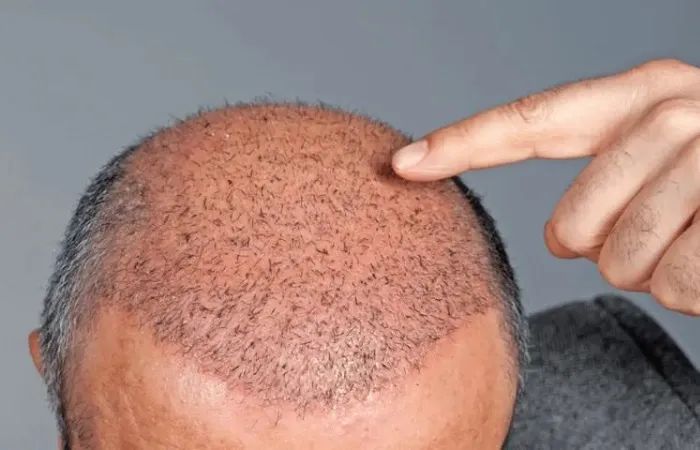ISLAMABAD – Medical experts in Pakistan are raising red flags over a surge in hair loss cases, with estimates showing that nearly 70% of Pakistani men suffer from some form of baldness by middle age. Even more alarming, many young men are reporting hair loss as early as their 20s.
The widespread issue has not only triggered medical concerns but also become a source of humor and social commentary. Some young men are now being mistaken for “uncles” due to their prematurely mature appearances.
Global Trends Reflect Widespread Hair Loss
While hair loss in Pakistan has reached epidemic levels, global data show that the trend is far from unique to South Asia. According to new findings from Medihair, a German medical research company, the highest rates of male hair loss are seen in Western nations. Spain leads with 44.50%, followed by Italy (44.37%) and France (44.25%). Other Western countries such as the United States (42.68%) and Germany (41.51%) also rank high.
Despite these numbers, Pakistan’s rapid uptick in hair loss is becoming a serious public health concern, especially as it begins affecting women in increasing numbers.
Experts Cite Genetics, Stress, Diet, and Environment
At a recent seminar held in Islamabad, the Hair Transplant Society of Pakistan revealed that approximately 30 million Pakistanis are experiencing hair loss. Yet, the country has only around 150 qualified hair transplant surgeons—far short of the estimated 5,000 needed to meet demand.
Dr. Rana Irfan, President of the Society, noted that 20% of people in their 20s experience hair loss. This number increases to 40% by their 40s and hits 70% by their 60s.
He also warned that women are not immune to the trend. Genetic factors, illnesses, and chronic stress have led to a significant rise in hair loss among women, prompting an urgent call for gender-inclusive awareness and care.
Shortage of Certified Professionals Leads to Risky Treatments
The severe shortage of certified hair restoration professionals has created an opportunity for unqualified practitioners to enter the market. These individuals often provide low-cost, unsafe procedures that carry serious health risks, including infection, scarring, and permanent damage.
“The lack of regulation is creating a crisis of unsafe treatments,” said Dr. Irfan. “We need more trained professionals and better public education about hair loss prevention and treatment.”
Social Media and Stress a Silent Trigger, Warns Nutritionist
Islamabad-based nutritionist and fitness expert Ayza Zardad echoed the concern, identifying modern lifestyle trends as key contributors to early hair loss. “Diet is the foundation,” she emphasized in an interview with WE News English.
She cited the growing influence of social media, poor stress management, and unhealthy diets as major factors contributing to the rise in baldness among young adults. Genetics, while significant, is only one part of the puzzle, she added.
Zardad encouraged individuals to take a more holistic approach. “Structure your day around your body’s needs. It’s about detoxing your mind, managing stress, and creating space for emotional and physical health.”
Global Perspective: Western Countries Lead in Hair Loss Rates
According to Medihair’s 2024 global report, the top five countries with the highest male baldness rates are:
Spain – 44.50%
Italy – 44.37%
France – 44.25%
United States – 42.68%
Germany – 41.51%
These countries reflect a consistent trend seen in Western populations, where high stress, processed diets, and genetic predisposition play a significant role.
Australia (40.80%), Canada (40.94%), and the UK (40.09%) also reported high levels, while Asian countries like Japan (35.69%) and India (around 31%) fall in the mid-range. Indonesia had the lowest rate at just 26.96%.
Why the West Is Going Bald Faster
Experts point to several reasons why Western men may experience hair loss at higher rates:
Genetics: Caucasian men, especially those of Northern European descent, have a higher genetic predisposition to androgenic alopecia.
Diet: Western diets are often low in essential vitamins like D and B12, which are vital for hair health.
Lifestyle: Stress, sedentary habits, and reduced sun exposure all contribute to follicle damage.
Aging Population: Western countries typically have older populations, and age is a well-documented factor in hair loss.
Ethnicity also plays a key role. Caucasian men are more sensitive to DHT (dihydrotestosterone), a hormone known to cause follicle shrinkage. However, lifestyle and environmental conditions are significant contributors across all ethnicities.
Studies from the World Population Review and TripAdvisor Japan also support these findings. They cite genetics, aging, and nutrition as common causes behind high baldness rates in countries such as the Czech Republic and Japan.
The Takeaway: A Global Problem with Local Urgency
While Pakistan’s hair loss crisis mirrors global trends, its severity is exacerbated by a lack of qualified specialists and public awareness. From social pressures to health risks, the issue cuts deeper than vanity.
For the millions silently struggling, the need for education, better nutrition, and accessible medical care is more critical than ever.
You Might Be Interested In:
- Timothée Chalamet’s Subtle Nose Job Speculations
- Drew Barrymore, 50, Clarifies Plastic Surgery Rumors
- Teresa Giudice: Second Breast Augmentation Boosted My Confidence


